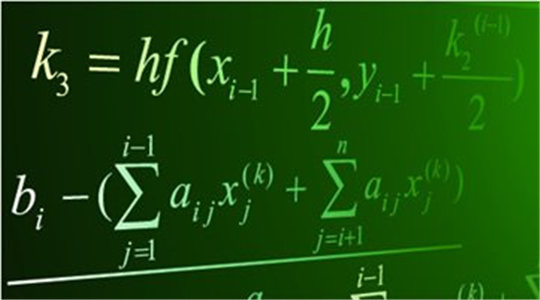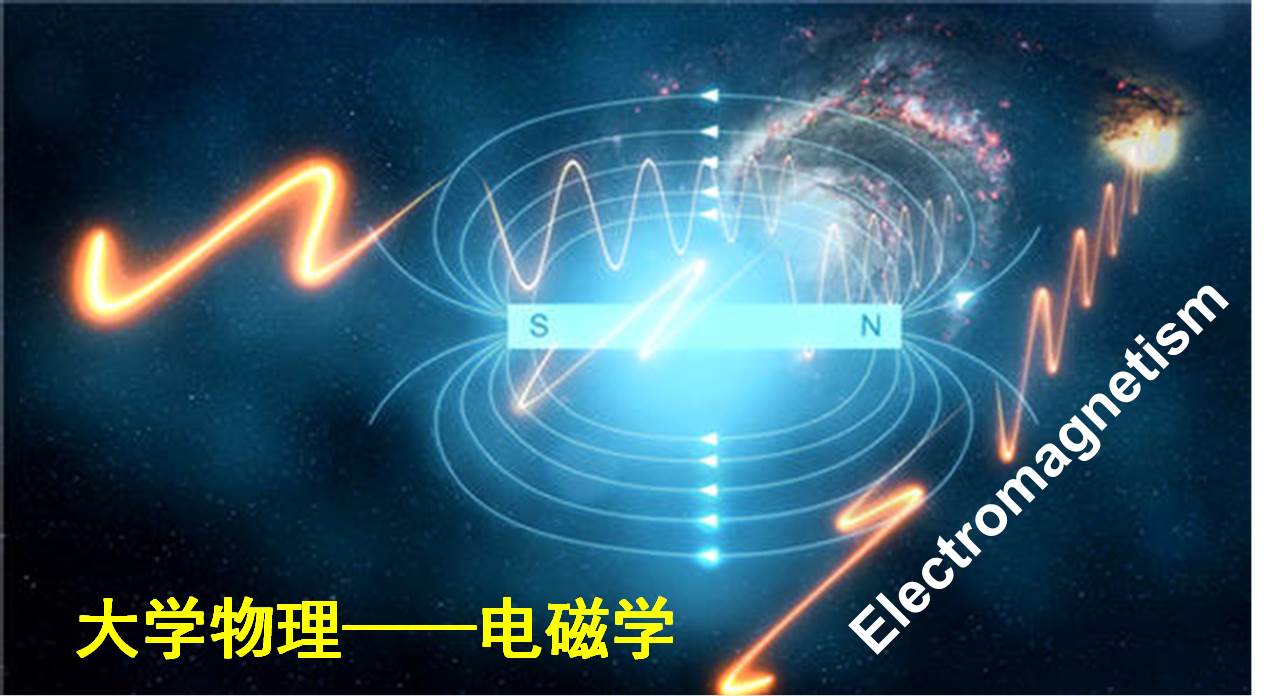
当前课程知识点:微积分-2 > Chapter 4 Differentiations of Multivariable Functions 多元函数微分学 (second part) > Unit 5 Continuous Multivariable Functions (连续多元函数) (section 1) > Continuous Multivariable Functions (连续多元函数) (section 1)
同学们 你们好
欢迎来到MOOC在线课程微积分
上一讲呢 我们学习了
欧式空间中的完备性 紧致 连通
等等定义和相关的定理
那这节课呢 我们要学习非常重要的内容
也就是 多元函数的极限
并且通过极限呢 引入
函数的连续性与一致连续性
这些内容啊 和我们以前学过的
一元函数 非常的相像
我们呢 将主要介绍使用
ε-δ语言来定义极限的方法
希望同学们呢 能够熟练掌握这种语言
我们下面呢 就从函数极限的严格定义讲起
Chapter 4
Differentiations of Multivariable Functions
多元函数微分学
Unit 5 Continuous Multivariable Functions
连续多元函数
Section 1 The Limit of Multivariable Functions
多元函数的极限
同学们 在以前的课程中呢
我们主要以三维欧式空间为例
讲述了三维空间的结构
比如说 内积 叉积等等
还有它里边的拓扑 完备性 连通性等等
那现在呢 我们要研究多元函数
这个多元函数啊
可以是二元函数也可以是三元函数
甚至是四元 n元等等
因此呢 现在我们要讨论
一般的n维欧式空间
下面呢 我们就把一般的n维欧式空间呢
给同学们讲述一下
So previously we had been considering
the 3-dimensional Euclidean space E3
以前 我们用的是这个符号
E3呢 表示三维的欧式空间
下面呢 我们要考虑n维的欧式空间
n维欧式空间实际上就是Rn
也就是n维的线性空间
但是呢 我们给这个n维线性空间Rn
赋予一个内积结构
an inner product
so that it becomes an inner product space
那么Rn的内积是怎样定义的呢
我们有标准的方法
它是这样给出来的 我们看啊
the standard n dimensional Euclidean space
whose inner product is defined by
我们现在看到的这个公式就是
如果第一个向量 注意它是一个n维向量
它的n个分量分别是x1到xn的话
而第二个向量y1到yn给出它的全部分量
那么它们两个之间的内积的结果就是
x1乘以y1加x2乘以y2一直加到xn乘以yn
so this defines the inner product of two vectors
注意 这里呢 我们讨论的是n维情况
因此呢 每一个指标都是从1跑到n的
它和我们三维的情况呢 是完全相仿的
另外呢 我们还有长度 也就是范数
English is called norm the norm is given by
注意这个符号就是对一个向量它的分量是
x1到xn的话 那么 它的norm就定义成
根号下x1的平方一直加到xn的平方
again the notation is the similar thing
as we had been using before
现在我们看到这个norm还是以前的方法
就是在一个向量的前面和后面加上两个竖线
表示它的范数也就是它自身的长度
以上呢 我们讨论的就是Rn
一个n维的线性空间 赋予了一个内积结构
因此呢 把这个赋予内积结构的这个Rn呢
就叫做n维的欧式空间
n dimensional Euclidean space
而且用特殊的符号En来表达
so we use En indicating that it is thus
endowed with the inner product
这就强调它具有内积结构
也就是具有长度 好的 那么下面呢
我们还要讨论别的结构
但是以前我们在三维欧式空间的时候呢
有一个重要的运算就是叉积cross product
那么现在n维空间有没有呢
实际上一般的n维空间
是没有叉积这个结构的
so except for n equals 3
we have the cross product
for other n we don’t have
such a product
除了这个叉积以外啊
以前的那些其他结构呢 大部分都能继承
比如说角度 我们还是用以前的方法来定义
那么现在呢 就是
除了跟叉积以外的我们都不要考虑
那么一个n维空间上的函数
它就变成一个
n variable function n元函数
那么n元函数 它通常的样子是这样的
我们现在呢 把它记成f
f它的自变量有n个 x1到xn
那么我们把x1到xn
看成一个向量的分量的话
就可以记成f(x) 注意
x上面画了一个箭头
表示x作为一个向量来看待
注意 我们还是要强调一个函数
通常要指定它的定义域
so we have to assign a domain of such a function
which should be a subset of En
因此呢 这个n元函数 它的定义域啊
通常是n维欧式空间的一部分
比如说 我们通常用D来表示
好了 明确了什么是n维函数
那么我们现在就要讨论
n元函数的极限这个概念
请看定义 limit
Let D be contained in En and f equals f(x)
which is a n variable function
好 现在考虑的这个n元函数就是f
那么所谓它在某一个点取的极限
是怎么定义的呢
我们需要给定一个点 比如说 l
Assume that l is a limit point of D
首先要明确啊
尽管我们要讨论f的极限
在某个点的极限 比如说l
但这个l呢
并不一定在f自身的定义域D中
它只需要在D的聚点之中就可以了
所以呢
we assume that l is a limit point of D
We say that the limit of f at this point l
is another number L
现在我们假设 要讨论的f
在这个向量l处的极限是一个数
这个数呢 用L来表达
那么它定义是怎样的呢
我们先看一下记号吧 就是
limit x趋近于l
注意 这个地方所谓x趋近于l
都是指的是向量的趋近 也就是
x作为一个向量趋近于l这个向量
而且这个过程中呢
x必须始终在f的定义域中
然后后面我们写一个f(x)箭头等于L
这就强调f作为一个多元函数
它在x趋近于l的时候的极限 是L
好 下面看定义
当然我们可以用另外一种办法写
就是简单一点的写法
我们现在看 就是这个屏幕右边的写法
它的定义是下面的 就是
for anyεpositive
there exists some δpositive such that
f(x) minus L the absolute value of this value
is less than ε
也就是说f(x) 和L的差值的绝对值要小于ε
对怎样的x呢 只要x充分靠近l
靠近到什么程度呢
那下面这个式子写得很清楚
holds true for all those x that belongs to
请看这个符号啊 B( l δ)
这表示距离l不超过δ的那个球的内部
而且呢 还怎样呢 我们注意后面有一个
交D
intersect with D
这个x呢 还必须在f的定义域中
否则无法定义
另外呢 注意最后一条
要minus l要去掉l这个点
也就是我们要强调这样的x
它在D的定义域中
它距离l的距离不超过δ
而且它不能是l本身
只要对所有这样的x满足
f(x)减去L的绝对值小于ε
那么我们就称这个
这样定义的这个极限就是
f在l处的极限L
总之这个定义呢 比较长
它有很多逻辑的部分 同学们
一定要仔细地品味其中每一句话的含义
同学们 在刚才这个定义中啊
我们要小心l不一定在f的定义域中
即便l在f的定义域中
那么f在l处的值和f在l处的极限
这通常是两个不同的概念
因此呢 同学们 不要把它们混起来
刚才我们定义极限的时候呢
我们是用ε-δ语言的
它表示这个函数在l附件的球状邻域中的
趋近的情况
实际上定义这个函数
在某个点的极限的时候呢
我们可以换另外一种方式
就是把它转化成数列极限去考虑
请看下面我们这种方法
Let D be contained in En and f D to R
be a function
仍然让我们考虑一个n元函数f
它定义在某一个区域D上
Assume that l is a limit point of D
还是假设l这个点 固定的点
我们要考虑f在这个点的极限的情况
首先假设l是D的自身的一个聚点
也叫极限点 好 下面请看
Then the limit of f as x approaches l is L
这就是我们要定义的这个情况
if and only if
下面就给出一个充分必要条件
它实际上给出了极限的另一个刻画
for any sequence pn
which is contained in D except l
也就是我们任取一个点列pn
它呢 是包含在D中
但是每一个pn都不是l
好的 对这样的点列pn
它满足什么条件呢
pn要趋近于l当n趋近于无穷的时候
as n going to infinity
pn is approximating l
and this condition one has that
the limit of f at pn
as n going to infinity equals l
那么我们把这句话再整体的翻译一下
就是说 f作为一个n元函数
它某个点l处的极限是大写的L
的充分必要条件可以这样刻画 就是
任取一个点列 这个点列呢 在D中
但是它不取到l
而且要求这个点列极限是l
只要满足这种情况的点列
f在这些点列上取值所得到的数列的极限
必须是大写的L
这样的话 我们就把一个f
作为一个n元函数的极限呢
转化成了f在一串点列上取值
也就是一个数列的极限的情况
实际上这两个是互相等价的
同学们 下面呢 我们简单的
说一下 为什么这个定理是正确的
我们给出一个非常简单的证明
这里边有很多细节是
需要同学们自己去填充的
我们呢 只给出一个简要的梗概
请看证明
The implication right arrow is obvious
我们现在呢 想说必要性
necessity
也就是说
只要f在l处的极限是大写的L
则结论成立
这个实际上是比较简单的
同学们只要把定义套下就可以了
因此呢 我们这里
就不需要重复每一个细节了
我们只需要证明反过来的情况
也就是left arrow
这个表示充分性
sufficiency
好的 我们看一下怎么证明充分性
也就是说
如果f在任取的点列上
它的极限也是大写的L
那么f在这个l处的极限也是大写的L为什么呢
we use negative approach
我们还是用反证法
If the claim is not true
假设这个反过来时候的事情是不对的
那么我们会得到怎样的结果呢
也就是说如果我们假设
limit as x approaches l f at x
the limit is not L
假设这个极限不是大写的L
那么按照逻辑定义 也就是说
there exists some ε positive
such that for any δ大于0
there always exists p in such a set
我们现在就是把f的极限是l的
那个定义啊 完全反过来
这里的逻辑关系
同学们一定要仔细想清楚了
好 存在这样的p属于B(l δ)交上D
而且呢 它要去除l这个点
对于这样的p呢 它要满足这个条件就是
f在p处的值减去L
整体的绝对值要大于等于ε
整个这段话实际上就是把f的极限等于L
完全反过来 因此呢 同学们
一定要仔细揣摩里面的每一个逻辑关系
如果我们假设 这件事情是对的
那么会导致怎么样呢
有了这样的假设
我们下面来做一个操作
我们从n等于1开始 也就是说
我们从第一步选取一个特殊的δ1
we start with δ1 which is assumed to be 1
选取这个特殊的δ1等于1
那么按照刚才的逻辑
我们马上就可以找到一个特殊的点
这个点是p1
find p1 as above
有了n等于1的情况
我们来找n等于2的情况
那么一般而言呢
我们要通过这种递推的方式来定义
就是
we find successively δn and pn
怎么定义呢 请看
首先如果第n步已经取定的话
那么第n+1步的δn+1要取成前面
那一步中的一个pn减去l的范数
和n分之一两者相比较
最小的那个数
这就是我们现在屏幕上写的δn+1
equals min 表示两者之间最小的那个
n分之一和另外一个数
就是pn与l之间的距离
好 取定这样的δn加1
然后再去找相应的p n加1
we can find some p n plus 1 where
that satisfy the above requirement
注意这个p n加1呢
它是距离l不超过δn加1
而且它在D中 也不能是l
按照这个递推关系
我们一步一步的就找出了δn pn
那么 我们观察
我们现在得到这个序列pn
它是一个n维欧式空间中的点列
它呢
obviously tends to l
这个pn啊 它是明显的趋近于l的
因为 每次这个pn和l的距离
都会小于n分之一
因此呢 它的确是趋近于l的
so we say that pn tends to l
but 我们要注意f(pn) 它可不趋近于L
这为什么呢 因为按照前面的那个假设
f(pn) 总是和L的距离要大于
那个事先给定的ε 所以呢
f(pn) does not approach to L
which is a contradiction
这和我们的一开始的假设就矛盾了
因此呢 我们说
这个定理 一定是正确的
另外 同学们 以前我们学过柯西准则
那么现在呢 把柯西准则
应用到函数极限的情况
就 有下面的
Cauchy criterion
adopted version of Cauchy criterion
Theorem 1.3.
Again that D be contained in En
and f a n variable function defined on D
好的 下面
Assume that l is a limit point of D
还是假设l是D的一个聚点之一
Then the limit of f at this point l exists
if and only if
我们要判定f在这个l处
是否有极限呢
柯西准则告诉我们
它存在的充分必要条件是
For any ε positive there exists
some δ positive such that
f(x) minus f(x’)
the absolute value of these two numbers
is less than ε
这句话的意思是说
f在l处极限存在的充分必要条件是
任意的ε大于0
总能找到充分小的δ大于0 使得
f在两个点之间的函数值之差小于ε
注意这两个点是有要求的
要求它必须是对所有的这样的x x’
它们呢 和l的距离不超过δ
而且在D中 而且也不能是l
还是我们以前的方式
So this should be holding true
for all such x and x prime
这个柯西准则呢 和我们以前见过的
数列极限的柯西准则
以及一元函数的柯西准则
以及n维空间中点列的柯西准则呢
是完全相仿的
因此同学们 应该不难理解
它为什么是这样叙述的
接下来 关于函数极限呢
还有另外一个形式的定理
我们也来看一下
Let D again be contained in En
and f a function defined on D
again let l be a limit point of D
好 前面这些条件呢
跟以前是一样的
接下来我们要断定
The limit f(x) as x approaches l exists
if and only if
现在呢 我们换另外一种方式来
判定这个极限是否存在
它是这么写的
for any sequence pn which is contained in D
and they are not l
也就是任选的一个序列pn
它包含在D中 但是每一个pn都不能是l
这样的点列pn
and again let pn approaching l
as n going to infinity
还是假设这个pn的极限呢 依然是l
那么我们要求
the limit f at pn exists
也就是说f在这些点上的
作为一个数列的值 它的极限要存在
这个和我们前面见过的那个定理啊
几乎是一样的
只不过 前面那个定理呢
我们假设了这个极限等于L
现在呢 我们并不知道这个极限是什么
我们只需要假设沿着每一个这样的点列
那么f在这些点上的值
构成的数列的极限存在
所以还是有一些区别的
那个证明方法呢
也几乎是完全相仿的
同学们不妨自己试一下
其实啊
关于这个函数极限的存在性啊
还有别的判别法
我们不妨再看另外一种情况
它是这样说的
条件都是一样的
Let D be contained in En
and f a function on D
and again l is a limit point of D
好了 现在我们判定
The limit of f(x) as x approaching l exists
这个f在l处的极限存在
充分必要条件是什么呢
if and only if
注意我们现在换了另外一种说法
是这样选的
for any continuous curve γ(t)
现在我们取的是任意的连续曲线
刚才我们选的是点列
现在我们取的是曲线
好 这个曲线呢 把它记成γ(t)
t的自变量范围呢 是0到1
而这个γ(t)啊
它 注意 它总是取它的那个值
也就是它这个
作为一个向量值函数啊
它的值呢 要在D
而且不是l
要满足这样的条件的曲线
而且呢 这个曲线
它在t趋近于0的时候
它的值趋近于l
满足这样条件的曲线
让f沿着这样曲线去跑
它的极限要存在
这句话理解起来比较费事
我们可以 不妨一点一点来重新梳理一下
也就是说我们要断定
f在某个点l处极限是否存在
我们呢 选取任意的连续曲线
这个连续曲线呢 注意
它本身是趋近于我们要找的那个点
就是l 另外呢
要求f沿着这些曲线取值的极限存在
当然存在的时候
如果它的极限是大写的L的话
那么整体f在那个l处的极限也是L
这个定理呢 实际上相当于
我们前面那些定理
把点列换成连续曲线而已
没有实质性的区别
同学们不妨自己思考一下如何证明
这个证明方法呢 应该是完全类似的
同学们 刚才我们讲了很多定理
这些定理呢 都非常抽象
我们下面呢 不妨看一个具体的例子
我们现在这个例子中呢
We consider f(x) as defined to be
x square y over x to the fourth plus y to the second
注意啊 这是一个二元函数
这个二元函数呢 它的自变量
我们不用x1 x2 而通常用x y来表示
好 现在
函数的定义式已经给出了
我们观察它在某个点的极限 哪个点呢
我们首先明确这个f定义的区域是
除去原点以外的全部的平面的点
也就是E2 minus(0 0)
这是它的定义域
那么我们要考察它在哪个点的极限呢
We want its limit at exactly (0 0)
也就是我们要考察在定义域以外的那个点
就是原点(0 0) 处f的极限如何
是否存在 存在会等于多少
这样的问题
好 下面呢 我们来研究一下
首先我们注意到
沿着一条线跑 也就是沿着x轴跑
也就是y要取成恒等于0
那么f(t 0) 当t趋近于0的时候
它的极限是0
再沿另外一条线
也就是沿着x等于t
y等于t平方
这样的连续曲线跑
也是当t趋近于0的时候
那么代入原来的函数呢
我们马上发现这个极限就是二分之一了
于是 沿着两条不同的连续曲线
它们的极限不相等
这件事情实际上已经告诉我们
f在(0 0)处的极限不可能存在了
因此呢
the limit f of (x y) as x y approaching 0
actually does not exist
-Introduction (课程介绍)
-Unit 1 Definition of Improper Integrals (广义积分的定义)(section 1)
--Definition of Improper Integrals (广义积分的定义)(section 1)
--Exercises-1-1-1
-Unit 1 Definition of Improper Integrals (广义积分的定义)(section 2)
--Definition of Improper Integrals (广义积分的定义)(section 2)
--Exercises-1-1-2
-Unit 2 Examples of Improper Integrals (广义积分的例子)
--Video-1-2 Examples of Improper Integrals (广义积分的例子)
--Exercise-1-2
- Unit 3 Tests of Convergence(收敛性判别)(section 1)
--Tests of Convergence(收敛性判别)(section 1)
--Exercises-1-3-1
- Unit 3 Tests of Convergence(收敛性判别)(section 1)--作业
- Unit 3 Tests of Convergence(收敛性判别)(section 2)
--Tests of Convergence(收敛性判别)(section 2)
--Exercises-1-3-2
- Unit 3 Tests of Convergence(收敛性判别)(section 2)--作业
-Unit 4 Absolute Convergence and Conditional Convergence (绝对收敛和条件收敛)
--Absolute Convergence and Conditional Convergence (绝对收敛和条件收敛)
--Exercise-1-4
--1-4讲义
-Test1
-Unit 1 Infinite Series and Their Convergence(无穷级数及其收敛性)
--Infinite Series and Their Convergence (无穷级数及其收敛性)
--Exercises-2-1
--2-1讲义
-Unit 2 Absolute Convergence and Conditional Convergence (绝对收敛与条件收敛)
--Absolute Convergence and Conditional Convergence (绝对收敛与条件收敛)
--Exercises-2-2
--2-2讲义
-Unit 3 More Tests for Convergence (更多的收敛性判别法)(section 1)
--More Tests for Convergence (更多的收敛性判别法)(section 1)
--Exercises-2-3-1
-Unit 3 More Tests for Convergence (更多的收敛性判别法)(section 2)
--More Tests for Convergence (更多的收敛性判别法)(section 2)
--Exercises-2-3-2
-Unit 3 More Tests for Convergence (更多的收敛性判别法)(section 3)
--More Tests for Convergence (更多的收敛性判别法)(section 3)
--Exercises-2-3-3
--2-3讲义
-Test2
-Unit 4 Sequences and Series of Founctions(函数项数列与函数项级数)(section 1)
--Sequences and Series of Founctions(函数项数列与函数项级数)(section 1)
--Exercises-2-4 (section 1)
-Unit 4 Sequences and Series of Founctions(函数项数列与函数项级数)(section 2)
-- Sequences and Series of Founctions(函数项数列与函数项级数)(section 2)
--Exercises-2-4 (section 2)
--2-4讲义
-Unit 5 Uniform Convergence(一致收敛性)(section 1)
--Uniform Convergence(一致收敛性)(section 1)
--Exercises-2-5(section 1)
-Unit 5 Uniform Convergence(一致收敛性)(section 2)
--Uniform Convergence(一致收敛性)(section 2)
--Exercises-2-5(section 2)
--2-5讲义
-Unit 1 Power Series (幂级数)(section 1)
--Power Series (幂级数) (section 1)
--Exercise-3-1(section 1)
-Unit 1 Power Series (幂级数)(section 2)
--Power Series (幂级数)(section 2)
--Exercise-3-1 (section 2)
--3-1讲义
-Unit 2 Expansion of Functions in Power Series (函数的幂级数展开)
--Expansion of Functions in Power Series(函数的幂级数展开)
--Exercise-3-2
--3-2讲义
-Unit 3 Fourier Expansion (Fourier级数展开) (section 1)
--Fourier Expansion(Fourier级数展开)(section 1)
--Exercise-3-3(section 1)
-Unit 3 Fourier Expansion (Fourier级数展开) (section 2)
--Fourier Expansion(Fourier级数展开)(section 2)
--Exercise-3-3(section 2)
--3-3讲义
-Unit 4 Convergence of Fourier Series(Fourier 级数的收敛性)(section 1)
--Convergence of Fourier Series(Fourier 级数的收敛性)(section 1)
--Exercise-3-4(section 1)
-Unit 4 Convergence of Fourier Series(Fourier 级数的收敛性)(section 2)
--Convergence of Fourier Series(Fourier 级数的收敛性)(section 2)
--Exercise-3-4(section 2)
--3-4讲义
-Unit 5 Other Forms of Fourier Series(其他形式的Fourier级数)
--Other Forms of Fourier Series(其他形式的Fourier级数)
--Exercise-3-5
--Test3
--3-5讲义
-Unit 1 Euclidean Space (欧几里德空间) (section 1)
--Euclidean Space (欧几里德空间) (section 1)
--Exercise-4-1-1
-Unit 1 Euclidean Space (欧几里德空间) (section 2)
--Euclidean Space (欧几里德空间) (section 2)
--Exercise-4-1-2
-Unit 1 Euclidean Space (欧几里德空间) (section 3)
--Euclidean Space (欧几里德空间) (section 3)
--Exercise-4-1-3
--4-1讲义
-Unit 2 Curves and Surfaces (曲线与曲面) (section 1)
--Curves and Surfaces (曲线与曲面) (section 1)
--Exercise-4-2-1
-Unit 2 Curves and Surfaces (曲线与曲面) (section 2)
--Curves and Surfaces (曲线与曲面) (section 2)
--Exercise-4-2-2
-Unit 2 Curves and Surfaces (曲线与曲面) (section 3)
--Curves and Surfaces (曲线与曲面) (section 3)
--4-2讲义
-Unit 3 Point-Set Topology of E3 (E3中的点集拓扑) (section 1)
--Point-Set Topology of E3 (E3中的点集拓扑) (section 1)
--Exercise-4-3-1
-Unit 3 Point-Set Topology of E3 (E3中的点集拓扑) (section 2)
--Point-Set Topology of E3 (E3中的点集拓扑) (section 2)
--Exercise-4-3-2
-Unit 3 Point-Set Topology of E3 (E3中的点集拓扑) (section 3)
--Point-Set Topology of E3 (E3中的点集拓扑) (section 3)
--Exercise-4-3-3
--4-3讲义
-Unit 4 Completeness and Connectness (完备性与连通性) (section 1)
--Completeness and Connectness (完备性与连通性) (section 1)
--Exercise-4-4-1
-Unit 4 Completeness and Connectness (完备性与连通性) (section 2)
--Completeness and Connectness (完备性与连通性) (section 2)
--Exercise-4-4-2
--4-4讲义
-Unit 5 Continuous Multivariable Functions (连续多元函数) (section 1)
--Continuous Multivariable Functions (连续多元函数) (section 1)
--Exercise-4-5-1
-Unit 5 Continuous Multivariable Functions (连续多元函数) (section 2)
--Continuous Multivariable Functions (连续多元函数) (section 2)
--Exercise-4-5-2
-Unit 5 Continuous Multivariable Functions (连续多元函数) (section 3)
--Continuous Multivariable Functions (连续多元函数) (section 3)
--Exercise-4-5-3
--4-5讲义
-Unit 6 Partial Derivatives and Differentiability (偏导数与可微性) (section 1)
--Partial Derivatives and Differentiability (偏导数与可微性) (section 1)
--Exercise-4-6-1
-Unit 6 Partial Derivatives and Differentiability (偏导数与可微性) (section 2)
--Partial Derivatives and Differentiability (偏导数与可微性) (section 2)
--Exercise-4-6-2
-Unit 6 Partial Derivatives and Differentiability (偏导数与可微性) (section 3)
--Partial Derivatives and Differentiability (偏导数与可微性) (section 3)
--Exercise-4-6-3
--4-6讲义
-Unit 7 Jacobian Matrix and Directional Derivatives (雅克比矩阵与方向导数) (section 1)
--Jacobian Matrix and Directional Derivatives (雅克比矩阵与方向导数) (section 1)
-Unit 7 Jacobian Matrix and Directional Derivatives (雅克比矩阵与方向导数) (section 2)
--Jacobian Matrix and Directional Derivatives (雅克比矩阵与方向导数) (section 2)
--Exercise-4-7-1
--Exercise-4-7-2
-Unit 7 Jacobian Matrix and Directional Derivatives (雅克比矩阵与方向导数) (section 3)
--Jacobian Matrix and Directional Derivatives (雅克比矩阵与方向导数) (section 3)
--Exercise-4-7-3
-Unit 7 Jacobian Matrix and Directional Derivatives (雅克比矩阵与方向导数) (section 4)
--Jacobian Matrix and Directional Derivatives (雅克比矩阵与方向导数) (section 4)
--Exercise-4-7-4
--4-7讲义
-Test1
-Unit 8 Taylor's Theorem (泰勒定理) (section 1)
--Taylor's Theorem (泰勒定理) (section 1)
-Exercise-4-8-1
-Unit 8 Taylor's Theorem (泰勒定理) (section 2)
--Taylor's Theorem (泰勒定理) (section 2)
-Exercise-4-8-2
-Unit 8 Taylor's Theorem (泰勒定理) (section 3)
--Taylor's Theorem (泰勒定理) (section 3)
--4-8讲义
-Unit 8 Taylor's Theorem (泰勒定理) (section 3)--作业
-Unit 9 Applications of Gradients (梯度的应用) (section 1)
--Applications of Gradients (梯度的应用) (section 1)
-Unit 9 Applications of Gradients (梯度的应用) (section 2)
--Applications of Gradients (梯度的应用) (section 2)
--Exercise-4-9-2
--4-9讲义
-Unit 1 Multiple Integrals (重积分) (section 1)
--Multiple Integrals (重积分) (section 1)
-Unit 1 Multiple Integrals (重积分) (section 2)
--Multiple Integrals (重积分) (section 2)
--Exercise-5-1-2
-Unit 1 Multiple Integrals (重积分) (section 3)
--Multiple Integrals (重积分) (section 3)
--Exercise-5-1-3
--5-1讲义
-Unit 2 Triple Integrals (三重积分) (section 1)
--Triple Integrals (三重积分) (section 1)
--Exercise-5-2-1
-Unit 2 Triple Integrals (三重积分) (section 2)
--Triple Integrals (三重积分) (section 2)
--Exercise-5-2-2
-Unit 2 Triple Integrals (三重积分) (section 3)
--Triple Integrals (三重积分) (section 3)
--Exercise-5-2-3
--5-2讲义
-Unit 3 Line Integrals (曲线积分) (section 1)
--Line Integrals (曲线积分) (section 1)
--Exercise-5-3-1
-Unit 3 Line Integrals (曲线积分) (section 2)
--Line Integrals (曲线积分) (section 2)
--Exercise-5-3-2
--5-3讲义
-Unit 4 Surface Integrals (I) (第一型曲面积分) (section 1)
--Surface Integrals (I) (第一型曲面积分) (section 1)
--Exercise-5-4-1
-Unit 4 Surface Integrals (I) (第一型曲面积分) (section 2)
--Surface Integrals (I) (第一型曲面积分) (section 2)
--Exercise-5-4-2
-Unit 4 Surface Integrals (I) (第一型曲面积分) (section 3)
--Surface Integrals (I) (第一型曲面积分) (section 3)
--Exercise-5-4-3
-Unit 5 Surface Integrals (II) (第二型曲面积分) (section 1)
--Surface Integrals (II) (第二型曲面积分) (section 1)
-Unit 5 Surface Integrals (II) (第二型曲面积分) (section 2)
--Surface Integrals (II) (第二型曲面积分) (section 2)
--5-4讲义
-Unit 5 Surface Integrals (II) (第二型曲面积分) (section 3)
--Surface Integrals (II) (第二型曲面积分) (section 3)
--Exercise-5-5-1
--5-5讲义
-Unit 6 Some Theorems of Line and Surface Integrals (曲线与曲面积分的几个定理) (section 1)
--Some Theorems of Line and Surface Integrals (曲线与曲面积分的几个定理) (section 1)
--Exercise-5-6-1
-Unit 6 Some Theorems of Line and Surface Integrals (曲线与曲面积分的几个定理) (section 2)
--Some Theorems of Line and Surface Integrals (曲线与曲面积分的几个定理) (section 2)
-Unit 6 Some Theorems of Line and Surface Integrals (曲线与曲面积分的几个定理) (section 3)
--Some Theorems of Line and Surface Integrals (曲线与曲面积分的几个定理) (section 3)
--Exercise-5-6-2
--Exercise-5-6-3
--5-6讲义
-Unit 6 Some Theorems of Line and Surface Integrals (曲线与曲面积分的几个定理) (section 4)
--Some Theorems of Line and Surface Integrals (曲线与曲面积分的几个定理) (section 4)
-Unit 7 Field Theory (场论) (section 1)
--Field Theory (场论) (section 1)
-Unit 7 Field Theory (场论) (section 2)
--Field Theory (场论) (section 2)
--Exercise-5-7-1
-Unit 7 Field Theory (场论) (section 3)
--Field Theory (场论) (section 3)
-Unit 7 Field Theory (场论) (section 4)
--Field Theory (场论) (section 4)
--Exercise-5-7-2
--Test5
--5-7讲义




